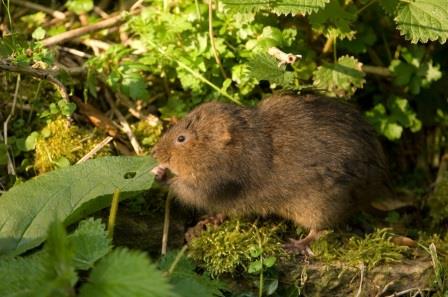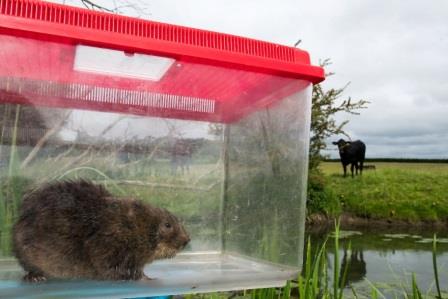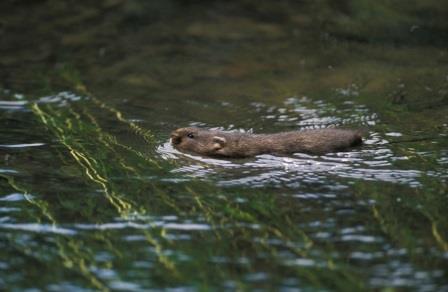News
Are water voles at risk from development? WildCRU research questions efficacy of mitigation technique.
The water vole, immortalised as ‘Ratty’ in Kenneth Grahams’ Wind in the Willows was formerly a common sight on waterways throughout mainland Britain. However, catastrophic declines due to predation from invasive American mink combined with habitat loss and fragmentation have resulted in the water vole now being considered one of Britain’s most endangered wild mammals. As such, water voles and their burrows are fully protected under the Wildlife and Countryside Act. Development works affecting the bankside create an additional pressure on remaining populations. Natural England created a licence to permit intentional disturbance of water voles with the idea of giving the voles a chance to move to safety before developers set to work. The procedure involved removing riverside vegetation, encouraging the voles to relocate, and then to destroy their burrows when they were safely out of harm’s way to prevent the animals’ return once works had commenced. Such activities, intended to conserve the water voles while enabling approved development, are licensed between mid-February and mid-April and must not exceed 50m of bankside length.
The WildCRU study found that the voles had other ideas. Radio-tracking water voles subjected to this procedure found that they often steadfastly stayed put. These findings published today in Conservation Evidence revealed no overall movement of water voles out of areas where displacement works had occurred. On the contrary, many voles remained faithful to their burrows. The guidelines had always insisted that destruction of burrows should be undertaken cautiously, and only during spring, in the hope of saving the lives of any water voles remaining. However, that was in the expectation that at most only a few bankside denizens would stubbornly refuse to shift. Now it seems the majority stand firm, shifting the balance of risks. This behaviour does not alter between spring and autumn, when vole populations are at their highest, and may be a function of the small area of vegetation being removed, so allowing the voles to remain within their original home range. The solution, while labour intensive, is imperative to protect water vole populations, say the researchers. It involves careful excavation of burrows exposed by vegetation removed by hand, and moving the water voles to adjacent habitat before the development works begin. With this vole-sensitive and life-saving approach, the researchers believe the displacement method can be a pragmatic and proportionate solution for small-scale developments where water voles are present.
Dr Merryl Gelling of WildCRU, was lead researcher for this study. “Water voles often remained in their burrows after vegetation removal occurred, highlighting the need for burrow excavation to proceed with caution to allow animals to relocate prior to development works starting. There was no difference in behaviour in either spring or autumn, suggesting that works under this licence could occur outside of the current mid-February to mid-April window, potentially reducing costly delays for development works. We are continuing to investigate the displacement technique with Natural England to better understand the implications for water vole populations”.
Professor David Macdonald, Director of WildCRU and co-author of the research, said: “While we might hope Toad is safe in Toad Hall, Ratty has been in peril, but our research offers a simple, practical solution. It’s a particular pleasure that WildCRU’s researchers have worked with government’s statutory agency, Natural England, to solve this practical problem, along with leading wildlife charities – a splendid example of all pulling together, and now we expect developers to follow suit”.
Professor Fiona Mathews, Chair of the Mammal Society says ‘we highlighted the urgent need for information on strategies intended to move water voles in our recent Water Vole Mitigation Guidelines. This research provides the evidence that removing vegetation — at least over distance of 50m or less — is not effective in moving water voles out of the way of development’.
Nida Al-Fulaij, Grants Manager at PTES, confirms, “We are worried about the state of our national water vole population. Huge efforts are being made to reverse the catastrophic decline of this iconic creature across the country. We welcome the results of this study which will help us provide better advice and manage our remaining populations to prevent any further decline.”
Katherine Walsh, Senior Mammal Specialist at Natural England added ‘Natural England is pleased to work with our partners to support proactive solutions for improving water vole conservation’.
The research was carried out in the Upper Thames region and predominantly funded by a partnership between Natural England, Peoples’ Trust for Endangered Species, The Mammal Society, Universities Federation for Animal Welfare, and Thames Water, with additional support from M&H Ecology Ltd, RSK Ltd, Arcadis, ERM Ltd, Ecosulis and the Environment Agency.
-

-

-
 All images © Andrew Harrington
All images © Andrew Harrington





